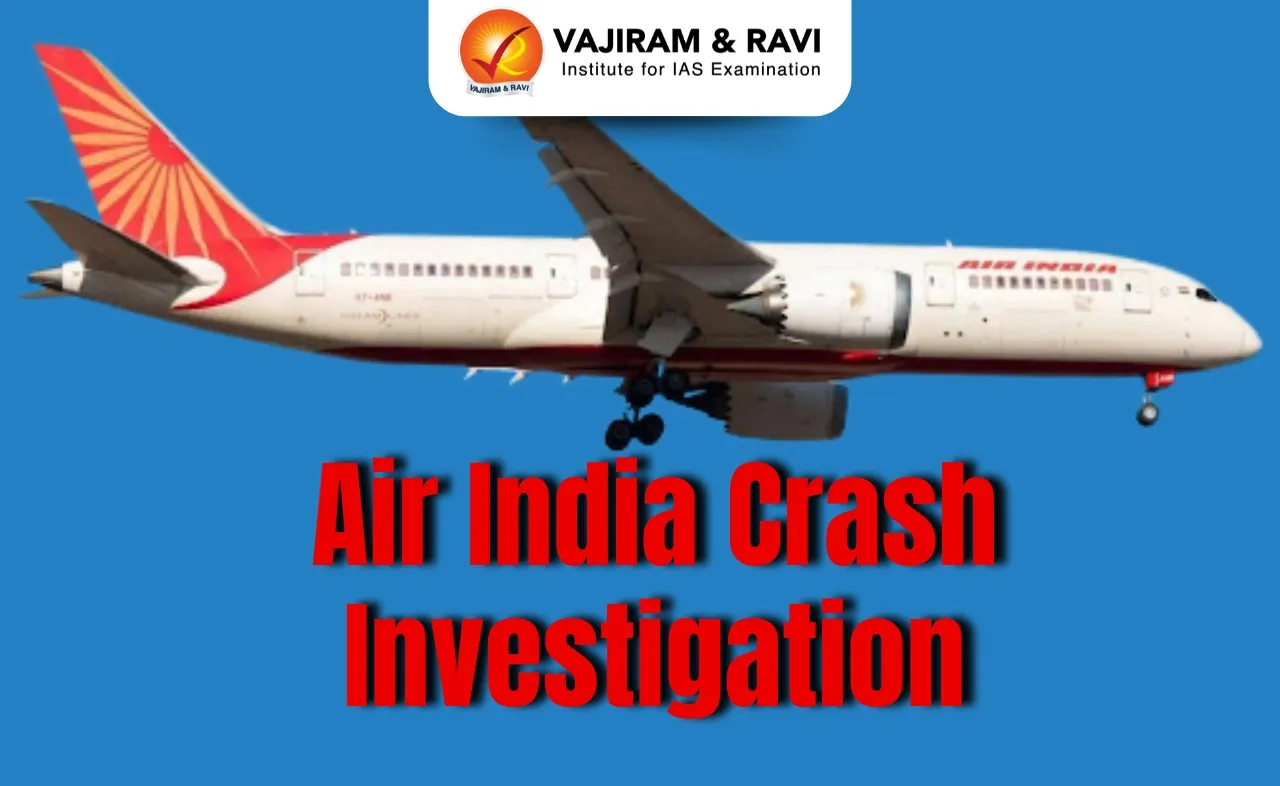Air India Crash Investigation Latest News
- When Air India flight 171 crashed in Ahmedabad, killing all 241 onboard, emergency services and media responded swiftly.
- Later, international agencies including the United States’ National Transportation Safety Board (NTSB), Federal Aviation Administration (FAA), and the United Kingdom’s Civil Aviation Authority (CAA) joined the investigation.
- This raises an important question: Why are foreign agencies, particularly from the US and the U.K., involved in investigating the crash of an Indian airline on Indian soil?
Why Foreign Agencies Investigate Air Crashes on Indian Soil
- The Role of the Chicago Convention
- The involvement of international investigators in air crashes is guided by the Convention on International Civil Aviation, also known as the Chicago Convention, signed in 1944.
- It was created to establish a unified global aviation framework to ensure safety and cooperation across nations.
- Global Commitment to Aviation Safety
- The Convention is upheld by 193 member countries, including India, the US, and the UK.
- Its technical standards are managed by the International Civil Aviation Organisation (ICAO), a UN body headquartered in Montreal.
- Annex 13: The Investigation Protocol
- A key component of the Convention, Annex 13, sets the international rules for investigating aircraft accidents.
- It ensures that investigations focus not on blame or legal responsibility, but on uncovering root causes to enhance future safety.
- Shared Responsibility
- Under Chapter 5 of Annex 13, countries involved in building the aircraft or its engines (like the US for Boeing aircraft) have a right and responsibility to participate in the investigation, even if the crash occurs outside their borders.
Who Can Participate in an Aircraft Accident Investigation
- Primary Responsibility: State of Occurrence
- Under Chapter 5 of ICAO Annex 13, the country where the accident occurs—called the State of Occurrence—leads the investigation.
- In the case of the AI 171 crash, this is India, and the probe is being conducted by the Aircraft Accident Investigation Bureau (AAIB) under India’s Ministry of Civil Aviation.
- Other Entitled States
- Several other countries have a formal right to participate in the investigation based on their connection to the aircraft:
- State of Registry: India (as the aircraft is registered with an Indian tail number starting with VT).
- State of the Operator: India (since Air India operated the flight).
- State of Design: United States (Boeing designed the aircraft).
- State of Manufacture: United States (Boeing and General Electric manufactured the plane and engines).
- Thus, US agencies like the NTSB and FAA are entitled to join the investigation. Boeing and GE may also send experts as part of the accredited team.
- Several other countries have a formal right to participate in the investigation based on their connection to the aircraft:
- Involvement of the UK
- Although not automatically entitled under Annex 13, the United Kingdom is participating because 53 British nationals were on board and perished in the crash.
- Such involvement is allowed as per ICAO provisions when nationals of a state are significantly affected.
- Scope of Participation
- All accredited participants are allowed to:
- Visit the crash site
- Examine wreckage and evidence
- Make technical submissions
- Receive and comment on the final report
- All accredited participants are allowed to:
A Practical Necessity, Not Overreach
- Global Collaboration for Aviation Safety
- The involvement of foreign agencies in crash investigations is not interference—it is a practical and essential step to ensure a thorough, technically accurate inquiry.
- In today’s globalised aviation industry, where aircraft are designed, built, and operated across multiple countries, safety is a shared international responsibility.
- Learning from Global Accidents
- A crash in one part of the world can reveal design flaws or operational issues relevant elsewhere.
- For instance, a lesson from a crash in India may prevent future accidents in Indonesia or the US, making cross-border participation vital.
- Established Precedent
- India has previously followed this protocol.
- In 2010, when Air India Express Flight 812 crashed in Mangalore, the US NTSB assisted in the investigation at the request of Indian authorities—illustrating that such cooperation is both routine and valuable.
Last updated on January, 2026
→ Check out the latest UPSC Syllabus 2026 here.
→ Join Vajiram & Ravi’s Interview Guidance Programme for expert help to crack your final UPSC stage.
→ UPSC Mains Result 2025 is now out.
→ UPSC Notification 2026 is scheduled to be released on January 14, 2026.
→ UPSC Calendar 2026 is released on 15th May, 2025.
→ UPSC Prelims 2026 will be conducted on 24th May, 2026 & UPSC Mains 2026 will be conducted on 21st August 2026.
→ The UPSC Selection Process is of 3 stages-Prelims, Mains and Interview.
→ UPSC Result 2024 is released with latest UPSC Marksheet 2024. Check Now!
→ UPSC Toppers List 2024 is released now. Shakti Dubey is UPSC AIR 1 2024 Topper.
→ Also check Best IAS Coaching in Delhi
Air India Crash Investigation FAQs
Q1. Why is the US involved in an Indian air crash probe?+
Q2. What is the Chicago Convention’s role in crash investigations?+
Q3. Who leads the Air India crash investigation?+
Q4. What other countries can participate in the investigation?+
Q5. Has India allowed foreign crash investigations before?+
Tags: air india crash investigation mains articles upsc current affairs upsc mains current affairs

















